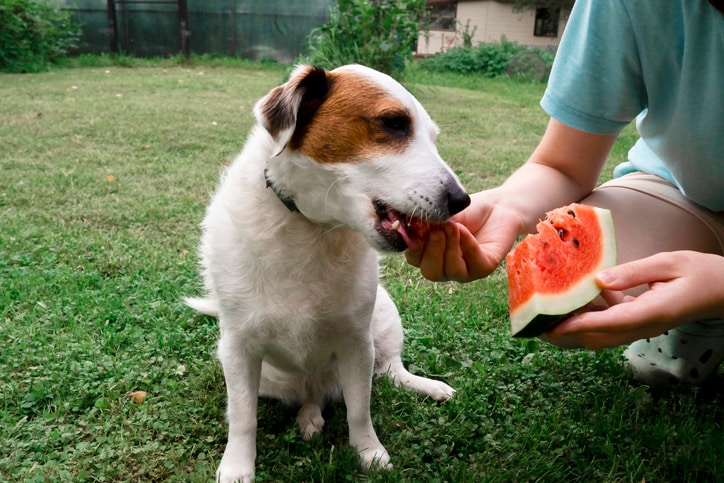It’s dinner time and your dog is hungry! Wet or dry food? What about freeze-dried, soft-moist or raw? To help you decide what type to pick, pet experts — veterinarians Dr. Norm Stillman, founder of Court Street Animal Hospital in Plymouth, Massachusetts, and Dr. Jeff Werber, founder of Century Veterinary Group in Los Angeles — offer their best dog food reviews, complete with the pros and cons of various types of food.
There’s no need to bring in a gourmet chef. In fact, dog foods such as venison, duck, bison or salmon, should be avoided, advises Dr. Stillman. “There’s nothing in a venison-based food that isn’t in a beef- or chicken-based food,” he notes, adding there’s no difference in nutritional value. “These foods are expensive and we reserve them for dogs who develop food allergies.”
He recommends that you stick with the highest quality food with the most “normal” ingredients you can find. He also suggests a “dental diet” — one that removes tartar from the teeth of dogs prone to periodontal disease. Dogs with very long or short skulls, he says, tend to have dental issues and benefit from this type of diet.
Wet Food
Have a panting dog on your hands? Wet food is a great source of added water, so it’s good for hydration, especially during the warmer months, or for small dogs who don’t drink enough and are prone to urinary tract problems. “Regarding taste, pets seem to prefer wet over dry. For puppies and senior pets, it is easier to eat,” says Dr. Werber. On the downside, there are fewer calories per gram and it is more expensive on a per-gram basis. Also, it doesn’t store well once the can is opened.
Wet Food Ingredients to Look For:
- Look for grain-free foods with chicken as the first ingredient with no artificial colors, flavors or preservatives. Try 4health Grain Free Chicken Canned Food.
- Wet foods with no grains and beef as the first ingredient are highly rated by dog-food sites. Try Blue Buffalo Blue’s Stew Canned Food.
Wet Food Ingredients to Avoid:
- Avoid foods that use meat by-products, soy flour and artificial ingredients.
- Avoid foods with water as the first ingredient along with chicken and meat by-products, vegetable oil and artificial colors.
Dry Food — Kibble
“Dry food is less expensive than canned food, is very energy efficient, easier to store, good for oral health — more abrasive on the tooth surfaces — and easier to feed,” says Dr. Werber. The cons are that many dogs don’t like it as much as canned food, he notes, and smaller breeds may have a harder time eating dry foods. The same applies to some puppies and senior pets.
Dry Food Ingredients to Look For:
- Dr. Stillman recommends foods that are good for dogs’ dental health like Hill’s t/d Canine Dog Food.
- Great try foods contain omega-3 and omega-6 fatty acids, which give dogs healthy, shiny coats. Try Merrick Classic Dog Food which contains nothing artificial and meat is the first ingredient.
- Research dog foods with high ratings for quality ingredients, with meat as the first ingredient and no by-product meals, soy or corn, BLUE Life Protection Formula is a great option.
Dry Food Ingredients to Avoid:
- Avoid dry foods that contain artificial colors and ingredients and use corn and by-product meal as the first ingredient. Also avoid dry foods that contain no real meat.
- Some dry food brands have grains as the first ingredient and contain corn syrup, artificial colors and propylene glycol, which is also used in antifreeze.
Raw Food
This type of food includes raw meats, bones, fruits and vegetables. Some owners claim it has restored the health of their dogs, but do your research and be sure to talk with your vet about this type of diet. Drs. Werber and Stillman both discourage the raw diet for dogs due to the high risk of bacteria the food might contain.
“A big concern is the possibility of bacteria, especially salmonella,” says Dr. Stillman. It’s important to know what type of processing is used to ensure the dangerous bacteria are destroyed. Another con is that this food is expensive and very messy.
Raw Food Ingredients to Look For:
- Try raw foods with a great balance. The right combination is 60 percent meat, 30 percent organ meat and 10-percent ground bone for balanced nutrition. Try Straight A+ Answers Raw Chicken Formula , which is sold frozen in biodegradable cartons, just thaw and spoon to serve.
- Great raw foods have raw beef as the first ingredient and also include vegetables. Try Bravo Balance Raw Beef Dinner -it comes as frozen patties packaged in easy-peel wrappers.
Raw Food Ingredients to Avoid:
- Avoid raw foods that use a mix of meat and organs as its main sources of animal protein. The fat content in these foods is higher than that of other raw foods and may not be appropriate for some dogs.
- Always check the ingredient list. Certain brands contain a mix of meat and organs, along with a lengthy list of extra ingredients, including montmorillonite clay — a controversial ingredient that carries with it a risk of contamination.
Freeze-Dried Food
Freeze-dried foods are essentially raw food but with the moisture removed. Make sure the food is truly freeze-dried and not dehydrated, which uses high heat levels to remove moisture and can affect nutritional value. Thoroughly read the directions on the package for serving as some require owners to add water to rehydrate and others do not. Also make sure to provide your dog with ample access to fresh water.
Freeze-Dried Ingredients to Look For:
- Great freeze-dried food is human-quality and grain-free with raw ingredients that are minimally processed in small batches. Try Fresh Is Best Freeze Dried Beef Dog Food. Each 8-ounce bag is approximately 2 pounds of raw food before moisture is removed. To serve, add equal parts tepid water to food and then serve.
- Think natural! A great choice is Stella and Chewy’s Chicken Dinner Patties, which contains 95 percent raw, cage-free chicken, bones and organs along with fruits and vegetables. Rehydration is not necessary with this food, but you can add some warm water if you prefer.
Freeze-Dried Ingredients to Avoid:
- Avoid freeze-dried food that contains beef, wild boar, lamb, pork and bison, which combines several meats that vets such as Dr. Stillman request owners refrain from using in case your dog develops an allergy.
Mixed Food
As both wet and dry food have benefits, many dog owners use a mix of both. What’s good about this is that the food then meets the increased water needs of some dogs and balances it with the higher caloric attributes of dry food. The disadvantage is that wet food doesn’t store as well, and since it’s being mixed with dry food, it won’t be used as fast.
Wet food is also more expensive. Soft-moist/mixed food is not made commercially, so you’ll need to choose a dry food brand and a wet food brand and mix them together in equal parts, then immediately feed the mix to your dog.
When it comes to feeding your dog, “there are many ‘best foods’ available,” says Dr. Werber. Read dog food reviews and ask your vet. “The foods one chooses should be certified by the AAFCO (Association of American Feed Control Officials) to make sure they are nutritionally balanced and sound. And the pet should readily like it! If the pet eats it and has good energy, a nice, shiny coat and firm stools, it’s a keeper!”
Laura Richards is a Boston-based freelance writer and the mother of four boys including a set of identical twins. She is also mom to three rescue pets: Scarlett, a 7-year-old Beagle, and Edith and Ollie, 15-year-old identical twin cats. She has written for numerous parenting publications and is the president of On Point Communications.


